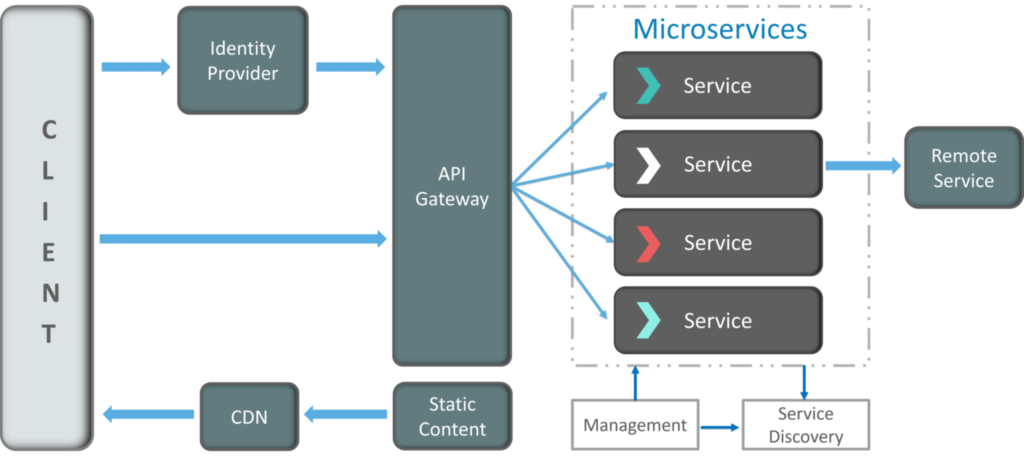Microservices Interview Questions
Prepare for your interviews with these top Microservices interview questions if you are keen on becoming a Microservices developer. Following is the list of most frequently asked Microservices Interview questions and their best possible answers.

1. What are microservices?
- Microservices were used to overcome the challenges of monolithic architecture that prevailed initially in the market and also enable you to deploy independent services.
- Microservices are small business services that can work together and can be deployed independently. These services communicate with each other by talking over the network and bring many advantages with them.
- The specialty of this microservice architecture is that polyglot architecture is supported. For example, if a team is working on one of the microservice using java, spring boot, and MySQL, another team can work on another microservice using python, Node JS, and NoSQL.
- Different microservices can use a different version of the same programming language.
- Different microservices can use different programming languages.
- Different microservices can use different architectures as well.
2. Why microservices?
- In the case of monolithic applications, there are several problems like
- The same code base for presentation, business, and data access layer. Application is deployed as a single unit.
- Complex to maintain and scalability is an issue.
- Microservice solves the above problems.
- Microservices are ideal when a monolithic or a legacy application needs to be modernized.
- For new software development, if the key business drivers are to reduce time to market, scalable better software, lower cost, faster development, or cloud-native development, microservices are ideal.
- Each service is independent and gives the flexibility to choose the programming language, database, and/or architecture.
- Distinct services can be developed, deployed, and maintained independently.
3. What are the pros and cons of microservice architecture?
Pros of microservice architecture
- Freedom to use different technologies.
- Each microservice focuses on a single responsibility.
- Supports individual deployable units.
- Allow frequent software releases.
- Ensure security of each service.
- Multiple services are parallelly developed and deployed
Cons of microservice architecture
- Management of a large number of services is difficult
- Communication between microservices is complex.
- Increased efforts for configuration and other operations.
- Due to the decentralized nature of microservices, more microservices mean more resources hence high investment.
- Debugging problems is harder unless the right instrumentation is followed during design and development.
- Microservices will need a large team size with the right mix of experience in design, development, automation, deployments, tools, and testing.
4. When to use microservices?
- Reduce time to market.
- Scalable better software
- Lower costs
- Faster development
- Cloud-native development
- It makes sense to adopt a microservices architecture if the team size is big enough as each service will require its team to develop, deploy and manage.
- The timeframe and skills of team members are a constraint.
- If fast results are required.
- Choose microservices architecture only if the team also has experience in microservices.
- Do not use this architecture for simple applications which can be managed by the monolithic application
- So if you use to ask yourself first do we really need this microservice architecture to decouple the services as it comes with a cost.
5. How does microservice architecture work?
The microservice architecture enables the rapid, frequent and reliable delivery of large, complex applications. A microservice architecture has the following components:

- Clients – Different users from various devices send requests.
- Identity Providers – Authenticates user or clients identities and issues security tokens.
- API Gateway – Handles client requests. An API gateway provides a single endpoint for the client applications, and it internally maps the requests to internal microservices.
- Static Content – Houses all the content of the system.
- Management – Balances services on nodes and identifies failures.
- Service Discovery – A guide to finding the route of communication between microservices. Service discovery is one of the services running under microservices architecture, which registers entries of all of the services running under the service mesh.
- Content Delivery Networks – Distributed network of proxy servers and their data centers.
- Remote Service – Enables the remote access information that resides on a network of IT devices.
6. What are the main features of microservices?
Microservices architecture breaks an application into smaller services, and it is possible to develop and deploy each service independently. This makes the introduction of nee features in an application very easier.
- Decoupling: Within a system, services are largely decoupled. The application as a whole can therefore be easily constructed, altered, and scalable.
- Agility – Microservices support agile development. Any new feature can be quickly developed and discarded again
- Continuous Delivery: Enables frequent software releases through systematic automation of software development, testing, and approval
- Componentization – Microservices are treated as independent components that can be easily replaced and upgraded
- Business Capabilities – Microservices are very simple and focus on a single capability
- Team autonomy: Each developer works independently of each other, allowing for a faster project timeline
- Decentralized Governance – The focus is on using the right tool for the right job. That means there is no standardized pattern or any technology pattern. Developers have the freedom to choose the best useful tools to solve their problems
- Black box – Every microservice is defined as a black box. The details of the complexity are hidden from other services/components.
- Polyglot
- This is one of the significant aspects of microservices architecture.
- For example, if a team is working on one of the microservice using Java, Spring Boot, and MySQL, another team can work on another microservice using Python, Node JS, and NoSQL.
- Different microservices can use a different version of the same programming language. E.g Java 8 and Java 11.
- Different microservices can use different programming languages.
- Different microservices can use different architectures as well.
7. How do microservices communicate with each other?
In the case of microservice architecture, there are 2 different types of inter-service communication between microservices.
- Synchronous communication
- Asynchronous communication
Synchronous communication
In the case of synchronous communication between microservices, the client service waits for the response within a time limit. The possible solution is using HTTP Protocol using via REST API for inter-service communication
Asynchronous communication
In the case of Asynchronous communication, the client service doesn’t wait for a response from another service. When the client microservice calls another microservice, the thread is not blocked till a response comes from the server. The message producer service generates a message and sends the message to a message broker on a defined topic. The message producer waits for only the acknowledgment from the message broker to know that message is received by the broker.
The consuming service subscribes to a topic in the messaging queue. All the messages belonging to that topic will ve fed to the consuming system(s). The message producer service and consuming service don’t even know each other. The response is received in the same methodology through a message broker via defined message topics.
Different messaging tools are based on the AMQP (Advanced Message Queuing Protocol). Some examples are given below.
- Apache Kafka
- RabbitMQ
- Apache ActiveMQ
8. What is the difference between Monolithic, SOA, and microservice architecture?
- Monolithic Architecture is similar to a big container wherein all the software components of an application are assembled together and tightly packaged.
- A Service Oriented Architecture is a collection of services that can communicate with each other. The communication can involve either simple data passing or it could involve two or more services coordinating some activity.
- Microservice architecture is an architectural style that structures an application as a collection of small autonomous services modeled around a business domain.
- The main difference between SOA and Microservice architecture is based on sharing of data and info. SOA shares and reuses as much as possible while Microservices focuses on sharing as little as possible.
9. How to design microservices?
- Microservices need to be designed by making use of the best practices like
- A separate data store for each of the microservice.
- The application needs to be split into loosely coupled microservices based on business functionality.
- Decentralized framework.
- Polyglot architecture as per the business needs.
- Services to be designed, developed, deployed, and managed separately.
- Domain-driven design
- Real-time monitoring of the application should be possible.
- Deploy in containers.
10. What are the challenges faced while using Microservices?
- Microservices always rely on each other. Therefore, they need to communicate with each other.
- As it is distributed system, it is a heavily involved model.
- If you are using Microservice architecture, you need to be ready for operations overhead.
- You need skilled professionals to support heterogeneously distributed microservices.
11. What is End to End Microservices Testing?
End-to-end testing validates every process in the workflow is functioning correctly. It also ensures that the system works together as a whole and satisfies all requirements.
12. Why are containers used in Microservices?
Containers are the easiest and most effective method to manage the microservice-based application. It also helps you to develop and deploy individually. Docker also allows you to encapsulate your microservice in a container image along with its dependencies. Microservice can use these elements without additional effort.
13. What are the important design patterns used in Microservices architecture?
- Database per Service Pattern
- Gateway Routing Pattern
- Gateway Aggregation Pattern
- API Gateway Pattern
- Backends for Frontends Pattern
- Circuit Breaker Pattern
- Service Aggregator Pattern
- Service Registry Pattern
- CQRS Design Pattern
- Event Sourcing Pattern
- Materialized View Pattern